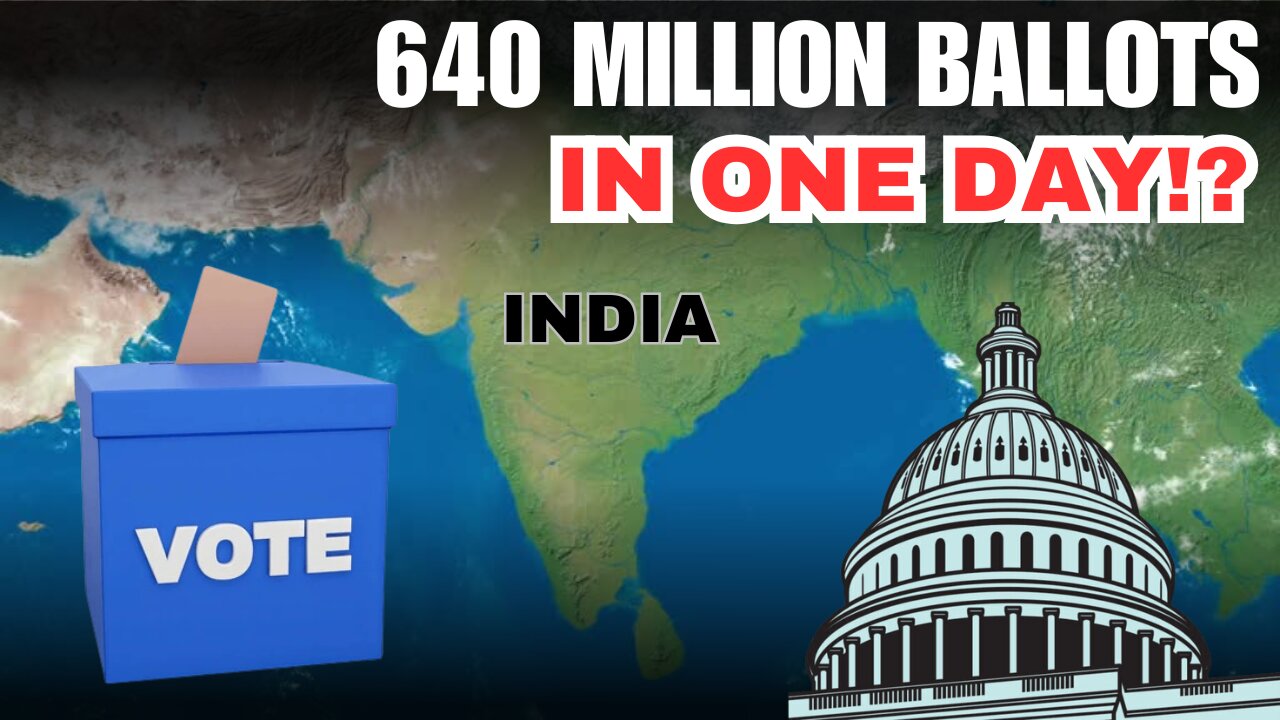Premium Only Content

India Counted 640 Million Votes In One Day!?
ChromoCast #4
**I realized I didn't clarify that in the US the senate and house determine the NUMBER of electors they are not the electors themselves.
Intro:
-Good opportunity to discuss the philosophical differences between the function of the two systems.
- 640 Million votes in one day and were not supposed to be sketched out by the fact that there are still 300k votes left to be counted half a month after the election?
Discussion
- Outcome and Purpose:
- India’s Electoral College prioritizes proportional representation to uphold the principle of democracy in a parliamentary system.
- The U.S. Electoral College emphasizes federalism and state sovereignty to ensure geographical diversity and prevent the dominance of densely populated urban areas.
1. The Irony of Delayed Results
- Elon Musk -"India counts 640 million votes in one day, while parts of the U.S. struggle to count a fraction of that weeks later."*
- Why do these systems work so differently, and what do these differences tell us about how democracy is structured in each country?
- Are these delays just inefficiency, or are they reflective of deeper structural and cultural priorities?
. Structural Similarities and Practical Differences
- Both systems aim to balance representation with democratic ideals.
- Both rely on intermediary bodies (Electoral Colleges) for electing their Presidents.
- India: Prioritizes efficiency: centralized election authority (Election Commission of India) ensures streamlined processes.
- U.S.: Prioritizes Soveriegnty: Decentralized processes mean each state controls its own election systems, leading to variability in speed, accuracy, and procedures.
2. Philosophical Differences Between the Systems
- India: Reflects a parliamentary democracy where proportional representation aligns with its population’s diversity.
- Votes in India's Electoral College are weighted by population, meaning more populous states and regions have greater influence.
- This system is more directly representative of the overall population, as it ensures areas with larger populations have a proportionally larger say in electing the President.
- However, this emphasis on population density offers less protection to smaller or less populous states and communities, increasing the risk of "rule by the majority."
- U.S.: Balances regional diversity in a federal system, emphasizing state sovereignty over pure population-based representation.
- The U.S. Electoral College gives states a mix of population-based electors (House representation) and state-based electors (Senate representation).
- Smaller states benefit from disproportionate representation, ensuring rural and less populous areas maintain significant influence in presidential elections.
- This design creates a hedge against majority rule, where the interests of urban centers could otherwise overshadow rural communities.
- India’s System:
- Philosophical trade-offs:
- India focuses on speed and centralization in its vote-counting process, prioritizing efficiency and inclusivity in one streamlined system.
- Provides a more accurate reflection of the population's overall will.
- Sacrifices the ability to protect less populous states or regions from being dominated by majority populations.
- U.S. System:
- The U.S. system prioritizes checks and balances through federalism, which can lead to localized autonomy but slower results.
- Ensures regional diversity and minority protection by amplifying the voice of rural states.
- Can result in outcomes where the national popular vote does not align with the elected President, reflecting a trade-off between federalist principles and pure democratic representation.
4. Why Delays in the U.S. Matter
-Broader challenges: effects of COVID election changes that were made permanent in many states, decentralized systems (non-uniform changes to election procedures state-by-state), mail-in ballots, and litigation.
-Are delays like these caused by changing and opaque election procedures in some states eroding trust in the system, especially when juxtaposed against a country like India managing over half a billion votes in one day?
5. Broader Implications and Takeaways
- India’s system is more efficient and representative of population size
- The U.S. system is deliberately slower and more complex, offering protections for minority voices ( rural communities)
Should the U.S. adopt a national standard that state election boards must meet for greater efficiency, or does the largely unregulated decentralized approach ultimately protect against national-level corruption and authoritarianism?
-
 LIVE
LIVE
Film Threat
16 hours agoTOM CRUISE IS BACK! STITCH FINAL WRECKONING | Film Threat Livecast
87 watching -
 LIVE
LIVE
The Shannon Joy Show
1 hour ago🔥🔥RFK’s Schizo HHS Recommends The COVID Booster For 2025/26 On The SAME DAY #MAHA Issues Report On Childhood Disease! It’s Friday Freestyle LIVE With Special Guest Dr. Naomi Wolf! 🔥🔥
285 watching -
 53:24
53:24
BitLab Academy
3 hours ago $0.26 earnedTrump Tariff Trap!! Bitcoin & Altcoin Great Buy Opportunity! (Watch these levels)
4.46K -
 LIVE
LIVE
Viss
2 hours ago🔴LIVE - Entering The Gray Zone Tasking & PVP - Open World Extraction!
81 watching -
 LIVE
LIVE
Side Scrollers Podcast
1 hour agoBIG DAY HUGE NEWS + LIVE REACTS + INDUSTRY MELTDOWNS | Side Scrollers LIVE
266 watching -
 1:01:32
1:01:32
VINCE
4 hours agoWhat Is In The Big Beautiful Bill Will Shock You - GUEST: Harmeet Dhillon | Episode 50 - 05/23/25
228K109 -
 2:45:17
2:45:17
The White House
3 hours agoVice President JD Vance Addresses the Naval Academy’s Class of 2025
42K5 -
 LIVE
LIVE
LFA TV
15 hours agoLFA TV LIVE STREAM - FRIDAY 5/23/25
6,062 watching -
 1:41:28
1:41:28
Caleb Hammer
2 hours agoI’m Going To Get Sued For This | Financial Audit
14.3K -
 1:18:36
1:18:36
The Big Mig™
5 hours agoSTOP The Soros’s! Should The USA Do The Same Now!
14.2K8